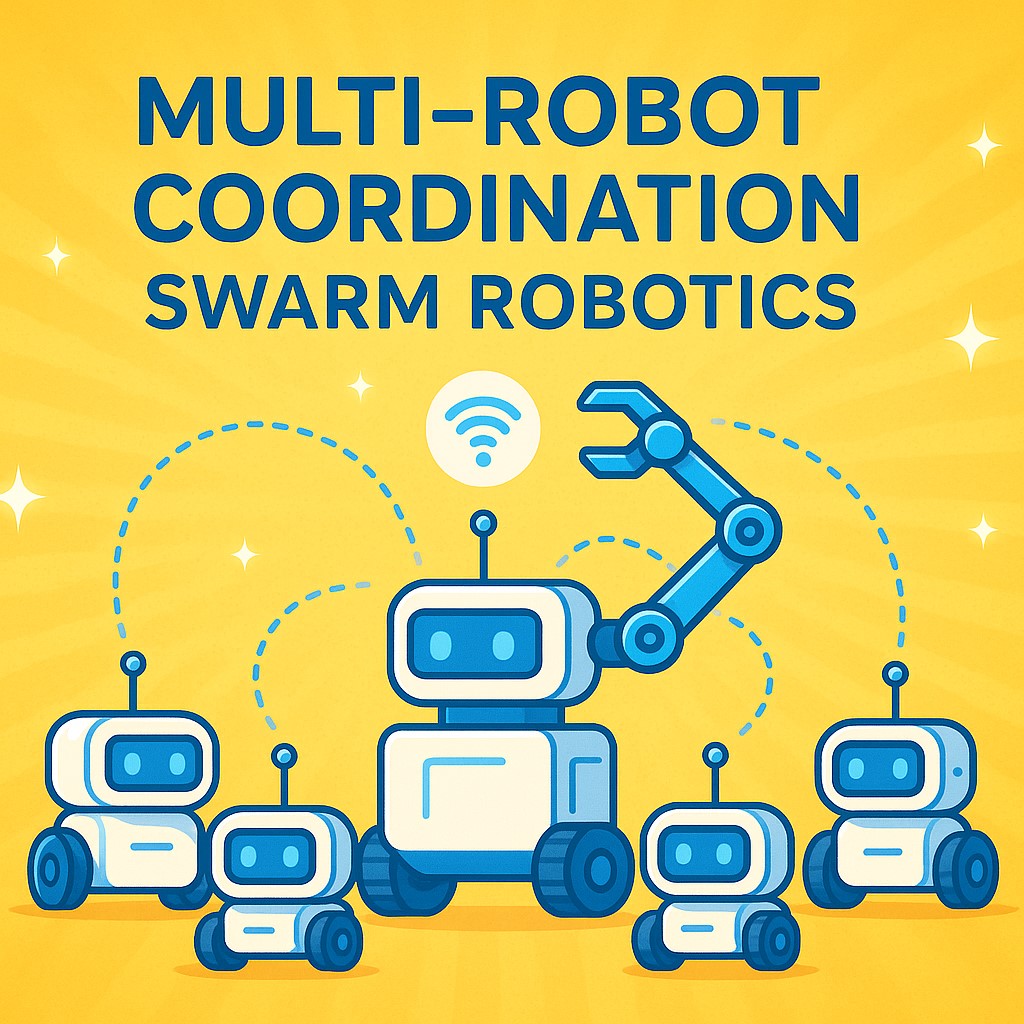Multi Robot Coordination For Swarm Robotics

Swarm robotics is an exciting and rapidly growing field inspired by the behavior of social insects like ants, bees, and termites. At the heart of swarm robotics lies a crucial concept: multi-robot coordination. This concept ensures that many simple robots can work together harmoniously to perform complex tasks that would be difficult, if not impossible, for a single robot to achieve alone. In this article, we will dive deep into what multi-robot coordination entails, why it is important, its key challenges, and emerging solutions — all with the aim to help you understand the powerful future it promises.
What Is Multi-Robot Coordination?
Multi-robot coordination refers to the methods and strategies that enable a group of robots to work together efficiently. Instead of acting independently, each robot follows a set of rules or communicates with its neighbors to ensure the entire swarm moves as a unified system.
The goal is simple: ensure collaboration without centralized control. In many swarm systems, there is no “leader” robot. Each robot must coordinate based on local information, similar to how birds flock or fish school. This decentralized approach gives swarm robotics its strength — scalability, robustness, and adaptability.
Key aspects of multi-robot coordination include:
-
Task Allocation: Assigning different roles or jobs to different robots.
-
Motion Coordination: Ensuring robots move without colliding or interfering with one another.
-
Information Sharing: Exchanging data between robots to enhance group decision-making.
Importance of Multi-Robot Coordination in Swarm Robotics
The value of multi-robot coordination is seen across many industries and applications. Here’s why it is so essential:
1. Scalability
Multi-robot systems can scale to hundreds or even thousands of robots. Proper coordination ensures that adding more robots increases efficiency without creating chaos.
2. Robustness
If one robot fails, the system can still function because tasks are distributed among many agents. Coordination allows swarms to continue operating even under unpredictable conditions.
3. Flexibility
Coordinated swarms can adapt quickly to changing environments. Whether it’s an unexpected obstacle or a new task, multi-robot coordination enables dynamic adjustments without human intervention.
4. Efficiency
Multiple robots working together can accomplish tasks faster than a single robot. For example, in warehouse logistics, coordinated robots can pick, pack, and deliver items simultaneously, reducing processing time.
Challenges in Multi-Robot Coordination
While the idea is appealing, achieving seamless coordination is complex. Several major challenges must be overcome:
Communication Limitations
In real-world scenarios, communication between robots can be unreliable due to interference, distance, or bandwidth constraints. Designing systems that can function with limited or no communication is critical.
Localization and Mapping
For effective coordination, robots must know their own position and the positions of others. Errors in localization can lead to collisions, inefficient movements, or task failures.
Decision-Making in Dynamic Environments
Swarm environments are often unpredictable. Robots must make fast, autonomous decisions based on partial or rapidly changing information, which adds complexity to coordination.
Energy Constraints
Many swarm robots are battery-operated. Coordinating their movements and tasks while optimizing energy consumption is a persistent challenge.
Popular Strategies for Multi-Robot Coordination
Over the years, researchers and engineers have developed several successful strategies to achieve effective multi-robot coordination for swarm robotics:
Behavior-Based Coordination
This approach relies on simple behaviors programmed into each robot. Examples include obstacle avoidance, flocking, and dispersion. By combining simple behaviors, complex group actions emerge naturally.
Example: In a search-and-rescue mission, robots can use obstacle avoidance behavior to navigate through debris while still maintaining a formation.
Leader-Follower Approach
In some systems, a temporary leader robot is designated. Other robots follow the leader’s movements, creating an organized formation. Leadership can rotate based on conditions like battery life or environmental factors.
Example: In agricultural tasks, a lead robot could guide a fleet of crop-monitoring drones across large fields.
Market-Based Coordination
Inspired by economic markets, this method assigns tasks based on bids from individual robots. Each robot evaluates its capabilities and availability, then “bids” for tasks.
Example: In warehouse automation, robots could bid to pick up items based on proximity, battery level, or current workload.
Consensus Algorithms
In this method, robots continuously update their own understanding of the world based on the information shared by neighbors. Over time, all robots “agree” on certain values, such as heading direction or task priorities.
Example: In environmental monitoring, drones could agree on pollutant concentration readings to decide which areas require more detailed scanning.
Applications of Swarm Robotics Using Multi-Robot Coordination
Today, multi-robot coordination in swarm robotics is being applied across many fields, including:
-
Environmental Monitoring: Swarms of drones map forests, monitor air pollution, and study wildlife without disturbing the ecosystem.
-
Disaster Response: Robots can quickly coordinate to search for survivors after earthquakes or floods, reaching areas too dangerous for humans.
-
Agriculture: Swarms plant seeds, monitor crops, and even perform pest control tasks with minimal human supervision.
-
Military and Defense: Coordinated robot swarms are being tested for surveillance, reconnaissance, and logistics in challenging environments.
-
Warehouse and Logistics: Companies use fleets of small robots that coordinate to transport goods, improving speed and reducing labor costs.
Future Trends in Multi-Robot Coordination for Swarm Robotics
The future of multi-robot coordination is bright and packed with innovation:
AI-Enhanced Swarms
Artificial intelligence, particularly machine learning, is being increasingly integrated into swarm systems. Robots will soon learn from their experiences, making coordination even more adaptive and intelligent.
Bio-Inspired Algorithms
Nature still has much to teach us. Scientists are studying termites, bees, and even bacteria to develop new coordination strategies that are efficient, scalable, and fault-tolerant.
Human-Swarm Interaction
Advances are being made to allow humans to intuitively control or influence swarm behavior using gestures, voice commands, or wearable devices. This will open up swarms to broader civilian applications.
Swarm-as-a-Service (SaaS)
Just like cloud computing, businesses may soon be able to “rent” a swarm of robots to perform tasks like surveying land, delivering packages, or even cleaning up hazardous waste sites.
Conclusion
Multi-robot coordination for swarm robotics is a groundbreaking advancement that blends engineering, biology, computer science, and artificial intelligence into a single, powerful force. Although challenges like communication constraints, localization, and dynamic decision-making remain, ongoing research continues to push the boundaries of what is possible.
From environmental monitoring to warehouse automation, coordinated robot swarms are already making a profound impact across industries. And with emerging trends like AI-enhanced learning and bio-inspired algorithms, the future of multi-robot coordination looks more exciting than ever.
If you want to stay ahead in this rapidly evolving field, understanding the fundamentals of multi-robot coordination for swarm robotics is essential. The next technological revolution might just swarm around you.
Key Takeaways
-
Multi-robot coordination is essential in swarm robotics, enabling large groups of robots to work together efficiently without centralized control.
-
Decentralized coordination enhances scalability, robustness, flexibility, and operational efficiency, making swarms capable of adapting to dynamic environments and growing in size without system failure.
-
Major challenges in multi-robot coordination include unreliable communication, localization errors, dynamic decision-making needs, and energy constraints.
-
Popular coordination strategies include behavior-based coordination, leader-follower models, market-based task allocation, and consensus algorithms, each suited for different types of tasks and environments.
-
Applications of swarm robotics are widespread, covering fields like environmental monitoring, disaster response, agriculture, military operations, and warehouse logistics.
-
Emerging trends like AI-enhanced swarms, bio-inspired algorithms, human-swarm interaction, and Swarm-as-a-Service (SaaS) are shaping the future of swarm robotics.
-
Nature-inspired solutions continue to influence advancements, with research focusing on mimicking efficient group behaviors found in animals and insects.
-
Artificial intelligence integration will make swarms smarter, more adaptable, and capable of handling increasingly complex tasks autonomously.
-
Multi-robot coordination is not only an academic pursuit but a practical solution already transforming industries, setting the stage for an exciting technological revolution.
-
Understanding multi-robot coordination is crucial for researchers, engineers, businesses, and technology enthusiasts looking to leverage swarm robotics for future innovations.
Reference
https://en.wikipedia.org/wiki/Swarm_robotics
Link License – https://en.wikipedia.org/wiki/Wikipedia:Text_of_the_Creative_Commons_Attribution-ShareAlike_4.0_International_License
Dear Friends, warmly welcome you to visit link below for more tech products recommendations. Thanks For Your Support.
https://techsavvo.com/category/tech-products/

